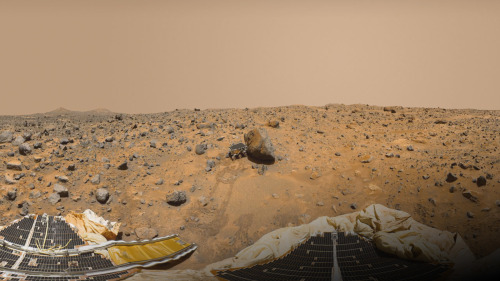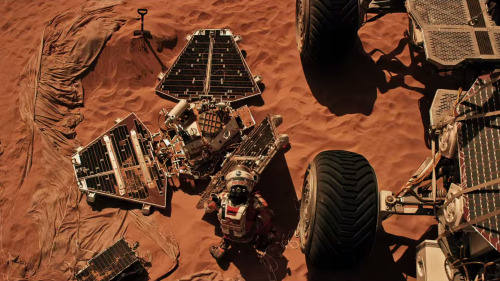Intergalacticnerd - Space N Shit

More Posts from Intergalacticnerd and Others

M104, the Sombrero Galaxy
Credit: Jimmy Walker




This is the coolest outer space animation ever. It shows the Crab Supernova explosion, happened in 1054, and its evolution into the remnant it is now - called the Crab Nebula. Basically a thousand years speeded up into less than a minute.
Modern understanding that the Crab Nebula was created by a supernova, an explosion of a massive supergiant star, dates to 1921 when Carl Otto Lampland announced he had seen changes in its structure. This eventually led to the conclusion that the creation of the Crab Nebula corresponds to the bright SN 1054 supernova recorded by Chinese astronomers in AD 1054. There is also a 13th-century Japanese reference to an appearance of a new or “guest” star in Meigetsuki. It was then so bright it was visible during the daytime for 23 days.
animation credit: ESA/Hubble (M. Kornmesser & L. L. Christensen)




Valles Marineris: The Grand Canyon of Mars
Image Credit: Viking Project, USGS, NASA
The largest canyon in the Solar System cuts a wide swath across the face of Mars. Named Valles Marineris, the grand valley extends over 3,000 kilometers long, spans as much as 600 kilometers across, and delves as much as 8 kilometers deep. By comparison, the Earth’s Grand Canyon in Arizona, USA is 800 kilometers long, 30 kilometers across, and 1.8 kilometers deep. The origin of the Valles Marineris remains unknown, although a leading hypothesis holds that it started as a crack billions of years ago as the planet cooled. Several geologic processes have been identified in the canyon. The above mosaic was created from over 100 images of Mars taken by Viking Orbiters in the 1970s.

The Trapezium is that a space ghost?
js






hubble’s panorama of the carina nebula, some 7500 light years away from earth, and about fifty light years in length here. stars old and new illuminate clouds of cosmic dust and gas, like the clumping hydrogen from which they were born.
the top star seen at the bisection of the first two panels, part of the eta carinae binary star system (most stars are in binary systems), is estimated to be more than a hundred times the mass of the sun - large enough to go supernoava in about a million years.
it also produces four million times as much light as the sun, and was once the second brightest star in the night sky. but surrounding dust and gas has dimmed our view of the star, though it’s still visible in the night sky to all but those in the most light polluted cities.
the fifth panel shows ‘the mystic mountain,’ where nascent stars in the dust cloud are spewing hot ionized gas and dust at 850,000 miles an hour. eventually, the ultraviolet radiation from these stars will blow away the dust, leaving visible the stars, like the cluster seen at the top of the panel, which were formed only half a million years ago.


Mars Pathfinder & Sojourner Rover (360 View) Explained
Thanks to new technology, we can take a 360-degree tour of the 1997 Pathfinder mission landing site, including Sojourner, the first Mars rover. Check out this interactive YouTube panorama, and then…
…keep scrolling to find out more about each point of interest, how the Pathfinder mission compares to “The Martian” and NASA’s real Journey to Mars.

Yogi
“Yogi” is a meter-size rock about 5 meters northwest of the Mars Pathfinder lander and the second rock visited by the Sojourner Rover’s alpha proton X-ray spectrometer (APXS) instrument. This mosaic shows super resolution techniques applied to help to address questions about the texture of this rock and what it might tell us about how it came to be.

Twin Peaks
The Twin Peaks are modest-size hills to the southwest of the Mars Pathfinder landing site. They were discovered on the first panoramas taken by the IMP camera on the July 4, 1997, and subsequently identified in Viking Orbiter images taken over 20 years ago. They’re about 30-35 meters tall.

Barnacle Bill
“Barnacle Bill” is a small rock immediately west-northwest of the Mars Pathfinder lander and was the first rock visited by the Sojourner Rover’s alpha proton X-ray spectrometer (APXS) instrument. If you have some old-school red-cyan glasses, put them on and see this pic in eye-popping 3-D.

Rock Garden
The Rock Garden is a cluster of large, angular rocks tilted in a downstream direction from ancient floods on Mars. The rocky surface is comprised of materials washed down from the highlands and deposited in this ancient outflow channel.

MOAR INFO
Pathfinder Lander & Sojourner Rover
Mission Facts [PDF]
Science Results
Rock & Soil Types


This vista was stitched together from many images taken in 1997 by Pathfinder.

Pathfinder and Sojourner figure into Mark Watney’s quest for survival on the Red Planet in the book and movie, “The Martian.” See JPL’s role in making “The Martian” a reality: http://go.nasa.gov/1McRrXw and discover nine real NASA technologies depicted in “The Martian”: http://go.nasa.gov/1QiyUiC.

So what about the real-life “Journey to Mars”? NASA is developing the capabilities needed to send humans to Mars in the 2030s. Discover more at http://nasa.gov/journeytomars and don’t forget to visit me when you make it to the Red Planet. Until then, stay curious and I’ll see you online.
Solar System: Things to Know This Week
Here are a few things you should know about our solar system this week:
1. Gearing Up for a Grand Finale

There’s just a year left until the Cassini mission begins its Grand Finale – the final phase of its mission, during which the spacecraft will dive repeatedly between the planet and the rings. To get ready, the Cassini team has launched an enhanced, mobile device-friendly version of the mission website. The site includes information about Cassini, Saturn, the moons and the rings – but it also tells the human stories behind one of the most ambitions expeditions of all time.
2.Caught in Transit

On Monday, May 9, the planet Mercury will cross directly in front of the sun, an event that hasn’t occurred since 2006 and won’t happen again until 2019. Find out how to watch HERE.
3. A Moon for Makemake

Our Hubble Space Telescope has spotted a small, dark moon orbiting Makemake (pronounced “MAH-kay MAH-kay). Make make is the second brightest icy dwarf planet – after Pluto – in the faraway Kuiper Belt.
4. The Age of the Aquarids

The Eta Aquarid meteor shower is the first of two showers that occur each year as a result of Earth passing through dust released by Halley’s Comet. This year, it should peak on the night of May 5/6. Get tips for watching HERE.
5. The Southern Lights of Saturn

On May 4, Cassini will reach periapse, the closest point to Saturn in the spacecraft’s orbit. At about this time, Cassini’s cameras will monitor Saturn’s south polar aurorae, and also image the bright limb of the planet to better understand its upper haze layers.
Want to learn more? Read our full list of the 10 things to know this week about the solar system HERE.
Make sure to follow us on Tumblr for your regular dose of space: http://nasa.tumblr.com

Pluto’s heart
This high-resolution image captured by NASA’s New Horizons spacecraft shows the bright expanse of the western lobe of Pluto’s “heart,” or Sputnik Planitia, which is rich in nitrogen, carbon monoxide and methane ices.
Credit: NASA/JHUAPL/SwRI

Gravitational Waves.
-
 laprincesse-s reblogged this · 5 years ago
laprincesse-s reblogged this · 5 years ago -
 szerencsetlen-lany-06 liked this · 5 years ago
szerencsetlen-lany-06 liked this · 5 years ago -
 fromsunrise-tillsunset reblogged this · 5 years ago
fromsunrise-tillsunset reblogged this · 5 years ago -
 nebulouswatercolor liked this · 5 years ago
nebulouswatercolor liked this · 5 years ago -
 amishacidheads reblogged this · 5 years ago
amishacidheads reblogged this · 5 years ago -
 defnsanity liked this · 5 years ago
defnsanity liked this · 5 years ago -
 unloveblebitchforever liked this · 5 years ago
unloveblebitchforever liked this · 5 years ago -
 ssweet-ssomeone reblogged this · 5 years ago
ssweet-ssomeone reblogged this · 5 years ago -
 dessadesdevious reblogged this · 5 years ago
dessadesdevious reblogged this · 5 years ago -
 aestheticsurrealism reblogged this · 5 years ago
aestheticsurrealism reblogged this · 5 years ago -
 the-honeymoon-avenue reblogged this · 5 years ago
the-honeymoon-avenue reblogged this · 5 years ago -
 the-honeymoon-avenue liked this · 5 years ago
the-honeymoon-avenue liked this · 5 years ago -
 honeybittersweet reblogged this · 5 years ago
honeybittersweet reblogged this · 5 years ago -
 counterpurrs liked this · 5 years ago
counterpurrs liked this · 5 years ago -
 m-dreamer-is-trans-inclusive liked this · 5 years ago
m-dreamer-is-trans-inclusive liked this · 5 years ago -
 eyeofpsyche liked this · 5 years ago
eyeofpsyche liked this · 5 years ago -
 sad-boyo-time reblogged this · 5 years ago
sad-boyo-time reblogged this · 5 years ago -
 reggeliikave reblogged this · 6 years ago
reggeliikave reblogged this · 6 years ago -
 taurusmo0n-blog reblogged this · 6 years ago
taurusmo0n-blog reblogged this · 6 years ago -
 doppelgangerblue liked this · 7 years ago
doppelgangerblue liked this · 7 years ago -
 glow1ngfern reblogged this · 7 years ago
glow1ngfern reblogged this · 7 years ago -
 fuckthis-and-fuckthat liked this · 7 years ago
fuckthis-and-fuckthat liked this · 7 years ago -
 on-neptunian-shores liked this · 7 years ago
on-neptunian-shores liked this · 7 years ago -
 mistressofthebats liked this · 7 years ago
mistressofthebats liked this · 7 years ago -
 artemislunareclipse reblogged this · 7 years ago
artemislunareclipse reblogged this · 7 years ago -
 artemislunareclipse liked this · 7 years ago
artemislunareclipse liked this · 7 years ago -
 bw1ti reblogged this · 7 years ago
bw1ti reblogged this · 7 years ago -
 httpeunoia reblogged this · 7 years ago
httpeunoia reblogged this · 7 years ago -
 httpeunoia liked this · 7 years ago
httpeunoia liked this · 7 years ago -
 i-write-fanfic-not-lab-repo-blog liked this · 7 years ago
i-write-fanfic-not-lab-repo-blog liked this · 7 years ago -
 will-ruadh liked this · 7 years ago
will-ruadh liked this · 7 years ago -
 starsandnovas reblogged this · 7 years ago
starsandnovas reblogged this · 7 years ago -
 clearyblind liked this · 7 years ago
clearyblind liked this · 7 years ago -
 bigheartgang liked this · 7 years ago
bigheartgang liked this · 7 years ago -
 sezckpord reblogged this · 7 years ago
sezckpord reblogged this · 7 years ago -
 the-chiweenie reblogged this · 7 years ago
the-chiweenie reblogged this · 7 years ago -
 airwair reblogged this · 7 years ago
airwair reblogged this · 7 years ago -
 acidtonguez reblogged this · 7 years ago
acidtonguez reblogged this · 7 years ago -
 wolfshadowhill liked this · 7 years ago
wolfshadowhill liked this · 7 years ago -
 theundisclosedlabspawndemon-blog liked this · 7 years ago
theundisclosedlabspawndemon-blog liked this · 7 years ago -
 hazecs-sauce liked this · 7 years ago
hazecs-sauce liked this · 7 years ago
"Astronomy compels the soul to look upwards and leads us from this world to another." - Plato
147 posts